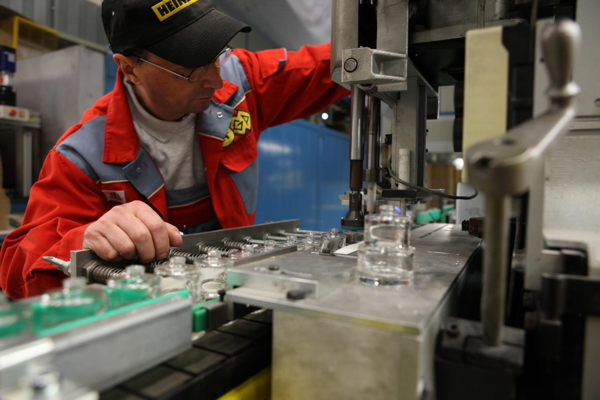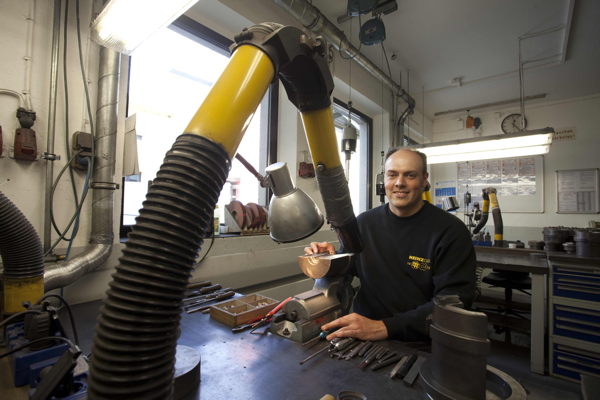The same keyword can be heard in each of the glass plants owned by the Heinz Group worldwide, "flexibility"! What are the solutions to make sure that this heavy industry- where every downtime on a furnace will amount in tens of millions of euros - takes up the challenges of its time, which are to keep up with fluctuations in demand, keep up with the creativity and responsiveness of a upscale perfumery and cosmetic market increasingly demanding in terms of deadlines, finishing options and often fluctuating quantities. It is totally baffling, when one imagines that each year, worldwide, more than a billion pieces are shipped with failure clearly not being an option.

"Quality", a second keyword for all glassmakers around the world, but a fundamental one too for teams at Heinz Glas who measured in the late 1990s, the long road still to go ahead, to have a chance of becoming one of the leaders in the high-end perfumery and cosmetics segment. From the early 2000s, engineers tackled the task so well that they were able to launch a line of ultra flat and heavy glass bottles, using the Heavy & Slim technique.
A fully integrated chain
The integration of the glass making group concerning mould manufacturing obviously proves to be a crucial move, allowing broader autonomy in developments and testing while strengthening capacity and responsiveness in terms of creativity.

The composition of glass was also the centre of attention to make it more transparent and radiant. Fire finishing techniques are reviewed and some tricks added to the process will prove to be crucial placing Heinz Glas among “the most beautiful glass on the market today!”
Combined production: a revolution!
But it is obviously in the manufacture of the bottle itself that revolution is on the way! Several years ago, a note dropped in the suggestion box by a member of the staff will change everything. A process which allows producing simultaneously on the same machine, parts different by their shape, weight or even their glass manufacturing process.
Benefits offered by this new technology are numerous. Size changes on production lines are progressive, at no time will the line be completely stopped, thus a gain in profitability. Plants gain in usable capacity. Schedule changes are easier to manage and with no major consequences on current productions. The loading of an extra bottle is very quick to implement. Plants responsiveness is improved. The choice of putting a product on the production line doesn’t depend of time, of the weight of the glass nor does it of the design of bottles already being produced or of the process under way. Factories gain in flexibility and can cope more easily with changes in market forecasts. Inventory management is directly optimized. The factory produces the appropriate quantities, so there is less stock, and stocks are more ephemeral, we are closer to a JIT inventory philosophy. Factories gain in cost reduction and in storage quality. Glass production becomes more profitable on a day to day basis. The minimum restocking for a bottle remains logically a day of production.

This is where the customer benefit concept really comes to the fore since a day’s production with two to three sections represents less than half the daily output of the line.
It is common knowledge that on a line with 8 single-format sections, the minimum quantity of parts required to start production is of 55,000 to 60,000 pieces. With the combination process, the minimum production at Heinz Glas drops to approximately 20,000 pieces.
To put it plainly, this means that at the request of a client, Heinz Glas can produce small batches. Which can be useful in the following situations:
– A new bottle launch for an emerging brand.
– Possible production for market tests.
– Placement of additional orders.
– Out of schedule emergency orders.
– Production of small series with appropriate quality levels.
– Maintaining on the market end of their shelf-life ranges.
"Perbuseal, the appropriate heat sealing method!

Another example of this ongoing commitment for innovation which is driving teams at Heinz Glas, the development of a in-house process "Perbuseal", a coating designed to heat the lip of a jar’s ring. As we know, heat sealing of opal jars is particularly difficult to achieve because leaching consecutive to hydroscopy reduces sealing properties. The coating developed by Heinz Glas consists in a neutral technical glass associated to organic oil. The support material is burnt without leaving any residue during the sintering operation, ensuring a constant thermoscellability even for a storage period of empty jars exceeding twelve months.





























